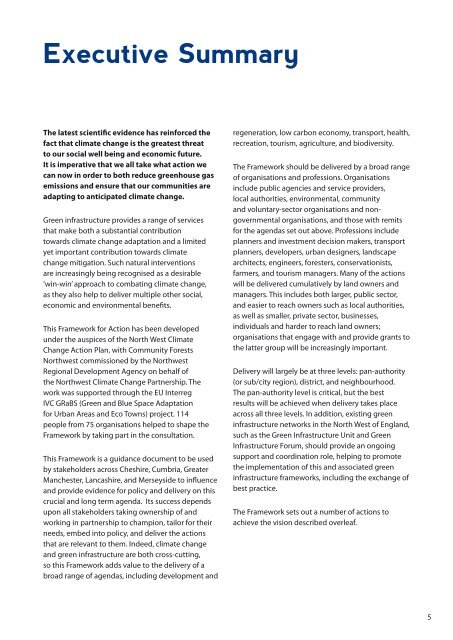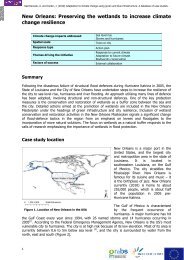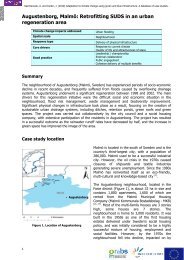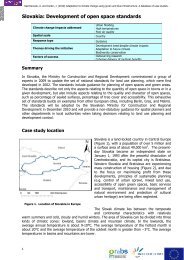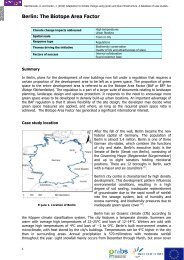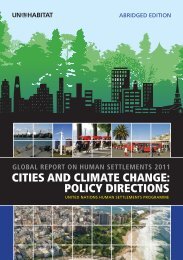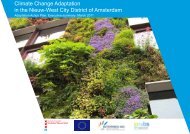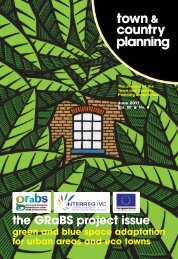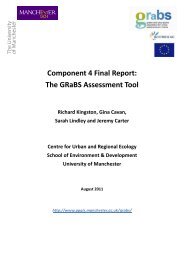Green Infrastructure to Combat Climate Change: A Framework for ...
Green Infrastructure to Combat Climate Change: A Framework for ...
Green Infrastructure to Combat Climate Change: A Framework for ...
Create successful ePaper yourself
Turn your PDF publications into a flip-book with our unique Google optimized e-Paper software.
Executive Summary<br />
The latest scientific evidence has rein<strong>for</strong>ced the<br />
fact that climate change is the greatest threat<br />
<strong>to</strong> our social well being and economic future.<br />
It is imperative that we all take what action we<br />
can now in order <strong>to</strong> both reduce greenhouse gas<br />
emissions and ensure that our communities are<br />
adapting <strong>to</strong> anticipated climate change.<br />
<strong>Green</strong> infrastructure provides a range of services<br />
that make both a substantial contribution<br />
<strong>to</strong>wards climate change adaptation and a limited<br />
yet important contribution <strong>to</strong>wards climate<br />
change mitigation. Such natural interventions<br />
are increasingly being recognised as a desirable<br />
‘win-win’ approach <strong>to</strong> combating climate change,<br />
as they also help <strong>to</strong> deliver multiple other social,<br />
economic and environmental benefits.<br />
This <strong>Framework</strong> <strong>for</strong> Action has been developed<br />
under the auspices of the North West <strong>Climate</strong><br />
<strong>Change</strong> Action Plan, with Community Forests<br />
Northwest commissioned by the Northwest<br />
Regional Development Agency on behalf of<br />
the Northwest <strong>Climate</strong> <strong>Change</strong> Partnership. The<br />
work was supported through the EU Interreg<br />
IVC GRaBS (<strong>Green</strong> and Blue Space Adaptation<br />
<strong>for</strong> Urban Areas and Eco Towns) project. 114<br />
people from 75 organisations helped <strong>to</strong> shape the<br />
<strong>Framework</strong> by taking part in the consultation.<br />
This <strong>Framework</strong> is a guidance document <strong>to</strong> be used<br />
by stakeholders across Cheshire, Cumbria, Greater<br />
Manchester, Lancashire, and Merseyside <strong>to</strong> influence<br />
and provide evidence <strong>for</strong> policy and delivery on this<br />
crucial and long term agenda. Its success depends<br />
upon all stakeholders taking ownership of and<br />
working in partnership <strong>to</strong> champion, tailor <strong>for</strong> their<br />
needs, embed in<strong>to</strong> policy, and deliver the actions<br />
that are relevant <strong>to</strong> them. Indeed, climate change<br />
and green infrastructure are both cross-cutting,<br />
so this <strong>Framework</strong> adds value <strong>to</strong> the delivery of a<br />
broad range of agendas, including development and<br />
regeneration, low carbon economy, transport, health,<br />
recreation, <strong>to</strong>urism, agriculture, and biodiversity.<br />
The <strong>Framework</strong> should be delivered by a broad range<br />
of organisations and professions. Organisations<br />
include public agencies and service providers,<br />
local authorities, environmental, community<br />
and voluntary-sec<strong>to</strong>r organisations and nongovernmental<br />
organisations, and those with remits<br />
<strong>for</strong> the agendas set out above. Professions include<br />
planners and investment decision makers, transport<br />
planners, developers, urban designers, landscape<br />
architects, engineers, <strong>for</strong>esters, conservationists,<br />
farmers, and <strong>to</strong>urism managers. Many of the actions<br />
will be delivered cumulatively by land owners and<br />
managers. This includes both larger, public sec<strong>to</strong>r,<br />
and easier <strong>to</strong> reach owners such as local authorities,<br />
as well as smaller, private sec<strong>to</strong>r, businesses,<br />
individuals and harder <strong>to</strong> reach land owners;<br />
organisations that engage with and provide grants <strong>to</strong><br />
the latter group will be increasingly important.<br />
Delivery will largely be at three levels: pan-authority<br />
(or sub/city region), district, and neighbourhood.<br />
The pan-authority level is critical, but the best<br />
results will be achieved when delivery takes place<br />
across all three levels. In addition, existing green<br />
infrastructure networks in the North West of England,<br />
such as the <strong>Green</strong> <strong>Infrastructure</strong> Unit and <strong>Green</strong><br />
<strong>Infrastructure</strong> Forum, should provide an ongoing<br />
support and coordination role, helping <strong>to</strong> promote<br />
the implementation of this and associated green<br />
infrastructure frameworks, including the exchange of<br />
best practice.<br />
The <strong>Framework</strong> sets out a number of actions <strong>to</strong><br />
achieve the vision described overleaf.<br />
5


